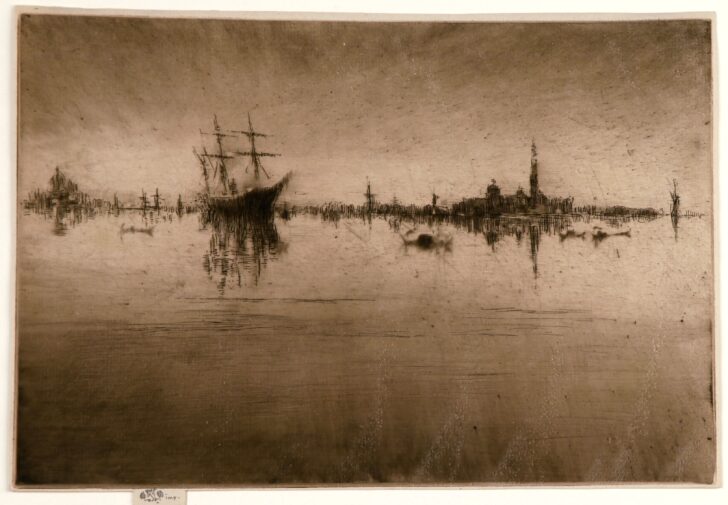Nocturne, from the “Twelve Etchings” or the “First Venice Set”
James Abbott McNeill Whistler

Description
Nocturne, from Twelve Etchings, or the
First Venice Set
1879–80
Etching and drypoint
Fourth state of five (Kennedy 184)
Bequest of Margaret Watson Parker, 1954/1.372
In this extremely understated image of a ship at anchor and the church of San Giorgio Maggiore, the skeletal line work clustering along the waterline is enhanced by the incorporation of drypoint, which evokes the palpable humidity of the Venetian lagoon. Gondolas executed entirely in drypoint dance below the fringe of vertical hatching describing the horizon and more extremely faint drypoint lines are used to describe the ghostly lights hung in the rigging and on the deck of the ship. These atmospheric details are augmented by the way Whistler manipulated the ink on the plate during printing: the dark areas at the top and bottom of the image not only evoke the gloom of nighttime, but also create a sense of depth.
In the different impressions of Nocturne, the bare matrix of etched lines that so minimally describes this scene is varied by colors of ink, types of papers, and, most significantly, the inking and resultant plate tone that give the image its rich atmospheric quality. The manipulation of these factors allowed Whistler to explore different effects and evoke various times of day; indeed, he achieved such a tremendous range of effects that each impression is almost a monoprint—a non-reproducible kind of print that is regarded as essentially a unique object.
(Whistler prints exhibition, 2010)
Gustave Le Gray
France, 1820–1884
The French Fleet, Cherbourg (La flotte française, Cherbourg)
1858
Albumen print
Department of Prints and Photographs, Bibliothèque nationale de France, Paris
James McNeill Whistler
United States, 1834–1903
Nocturne, from The First Venice Set
1879–80
Etching and drypoint
University of Michigan Museum of Art, Bequest of Margaret Watson Parker, 1954/1.372
The profoundly influential aestheticized painting style James McNeill Whistler pioneered in the mid-1860s may owe something to photographs taken by Gustave Le Gray years earlier. Among the photographer’s views of the 1858 visit of Napoleon III and Empress Eugénie to Cherbourg is this of the French fleet resting quietly at anchor, made from Le Gray’s collodion-on-glass negative. In the foreground, the water undulates in gentle swells while imposing three-masted ships dominate the image; the photograph combines an ethereal brightness near the horizon line with a gloomy darkness in the upper and lower portions of the image.
It is possible that Whistler may have had this or comparable images in mind when he created the series of etchings executed in Venice during his visit in 1879–80. Whether directly evoking Le Gray’s images of the French fleet or not, Whistler’s Nocturne bears a striking resemblance to Le Gray’s photograph. At the time he was working on the etchings of Venice, Whistler had begun to manipulate the ink on the etching plate to better achieve the sense of palpable atmosphere so inherent in his views of Venice, an approach known as “artistic printing.” Similarities between the two include the relative brightness at the horizon and the treatment of the water in the bottom of the image, particularly the way the faintest of etched lines describes the eddying movement of water. He also uses warm black ink with a tonality comparable to the albumen print. If Whistler did have Le Gray in mind, he has transformed the photograph into the most evocative and exquisite portrayal of ships at anchor.
This impression of the Nocturne was owned by the photographer Henri Le Secq.
(Normandy show, 2010)
Subject Matter:
Whistler frequently employed plate tone to evoke the rich humidity of Venice's climate. This image showing a large ship at anchor in the mouth of the Grand Canal conveys the palpable atmosphere of nighttime in Venice.
Prior to Whistler's adoption of "artistic wiping" of the plates, such use of plate tone would have been the mark of someone not proficient in printing techniques. Whistler varied the inking of this plate, in particular, such that impressions are essentially monoprints. However, use of plate tone became more broadly embraced and the Venice prints became among the most sought after of his etchings.
Physical Description:
This is a nighttime view of a city on water. Along the horizon can be seen numerous buildings and ships. At center left is a three-masted ship at anchor; along the right side are buildings, incuding domes and a tall tower. Throughout the image, there is an importance given to reflections and the nocturnal setting.
Usage Rights:
If you are interested in using an image for a publication, please visit https://umma.umich.edu/request-image/ for more information and to fill out the online Image Rights and Reproductions Request Form.